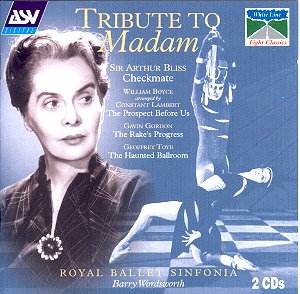At last we have the first commercially released recording
of Arthur Bliss’s complete Checkmate ballet score - just one
benefit of this splendid and fascinating tribute to Dame Ninette de
Valois (known affectionately throughout the world of ballet as 'Madam').
The Royal Ballet Sinfonia performs these contrasting scores (all complete)
with great affection and dedication. Under the inspired direction of
Barry Wordsworth, they make the music really dance.
The whole enterprise is a handsome production. The
fulsome booklet notes open with a biographical tribute from David Bintley,
Director, Birmingham Royal Ballet. There is a brief chronology of Ninette
de Valois’s life embracing all her ballets. Barry Wordsworth adds a
further tribute and Noël Goodwin contributes detailed programme
notes about all the ballets: their history, conception, choreography,
design and stories etc. This review will concentrate only on the music
(otherwise it would become too unwieldy) – all the other facets of the
ballets are covered in the CD booklet notes.
Bliss had a genuine love of dance (he went on to compose
three more ballet scores: Miracle in the Gorbals (1944), Adam
Zero (1946) and The Lady of Shalott (1958)). By Ninette de
Valois’s invitation, Bliss conceived Checkmate. The
strikingly imaginative idea of using a chess game as the subject for
a ballet offered great opportunity for heightened drama and visually
stunning sets and choreography. It was created for the Vic-Wells Ballet’s
first visit to Paris in 1937. The music has a diamond hard brilliance,
and is often violent and dissonant. For the combat between the allegorical
figures of Love and Death (the actual chess players as seen in the opening
prologue dancing to sombre sinister figures), the music is predominantly
angular and spiky. There are a few tender moments for the more placatory,
but doomed, red chess pieces, notably the Red Knight, before they are
duped and relentlessly decimated by their cruel black opponents led
by the dangerously seductive Black Queen. The ballet score includes:
a brittle, sprightly dance for the Red Pawns as they assemble on the
chess board; a chivalric theme for the pairs of Knights as they enter;
a feeble measure for the ailing Red King, a cruel seductive dance for
the sinister Black Queen, religious music, complete with bell-ringing,
for the Bishops, and belligerent mechanical material for the Castles,
borrowed from Bliss’s film score for Things to Come. Tremendously
exciting music, blistering and malicious, erupts as the victorious Black
Queen rounds on the defeated and impotent Red King who surrenders his
crown and falls before her. Nothing is as certain as death!
In complete contrast, the atmosphere lightens as the
music gives way to the elegance and refinement of the writing of William
Boyce (arranged by Constant Lambert) underscoring the 1940 ballet The
Prospect Before Us or Pity the Poor Dancers. It brought
welcome light relief in the dark days of war. The title and subject-matter
was derived from an 18th-century print by Thomas Rowlandson
(1756-1827) depicting popular low-life scenes in satirical caricatures
with boisterous humour and a larger-than-life sense of the ridiculous.
The ballet makes adept use of Boyce’s secular music (played with admirable
sparkle and vivacity by the Royal Ballet Sinfonia) including songs for
the London pleasure gardens and theatre music for plays. Constant Lambert
rescued some of this delightful music from centuries of neglect; he
also edited for publication eight Boyce symphonies and some Trio-sonatas.
From all of this material he fashioned a patchwork of single dance movements
for this de Valois ballet.
Gavin Gordon was inspired by a series of Hogarth paintings
to create another smash hit, the de Valois ballet, The Rake’s
Progress that was premiered in 1935. It has rarely left the
repertoire since. The paintings and the ballet concern the downfall
into penury and madness of a wealthy spendthrift and the fate of the
country girl he has betrayed. Gordon drew on 18th century
dance forms as found in the suites and sonatas of the period. The highly
evocative and sardonically ironic music is often ‘Haydnesque’ but with
the odd burlesque comic touches. A clever pastiche. There are dances:
stately, pompous, arrogant, tenderly romantic, poignant and demented
and turbulent for the madhouse scene.
Geoffrey Toye’s haunting waltz, The Haunted Ballroom
has always been a favourite on BBC radio light music programmes so the
complete ballet music is very welcome. And how imaginative it is in
its use of an eerie single SATB voice chorus commentary and its subtle
influences of Bax (in evocative misty cor anglais figures), Walton and
Eric Coates. Listening to the music of Scene Two it is hard to believe
that this was composed in 1934 because it uncannily anticipates popular
Second-World-War–period martial strains. This was the ballet that launched
the career of Margot Fonteyn (listed then as Margot Fontes) and featured
the dramatic agility of Robert Helpmann. Geoffrey Toye (1889-1942) was
co-director with Lilian Baylis at Sadlers Wells and co-conductor with
Constant Lambert of the ballet performances there. He composed The
Haunted Ballroom to a scenario mapped out by himself. It’s about
the Masters of Treginnis cursed to dance themselves to death in the
gloomy ancestral ballroom by the ghosts of their former womenfolk. After
the present Master meets his appointed fate, his son and heir is forced
by the ghosts to realise that the curse has now passed to him. David
Bintley says in his notes that the choreography of this ballet survives
only in tantalising fragments. A revival of this once popular ballet
would be most welcome.
A worthy tribute to the grande dame of the world
of ballet. This album is noteworthy as being the first recording of
Bliss’s complete Checkmate score and for the inclusion of Geoffrey
Toye’s haunting and captivating The Haunted Ballroom – again
complete. The recorded sound is first class and performances thrilling
and poetic.
Ian Lace


![]() Royal Ballet Sinfonia/Barry
Wordsworth
Royal Ballet Sinfonia/Barry
Wordsworth ![]() ASV CD WLS 255 (2
CDs: 151:13)
ASV CD WLS 255 (2
CDs: 151:13)